Green Solution House
Comfort
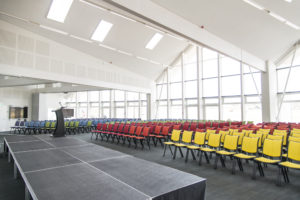
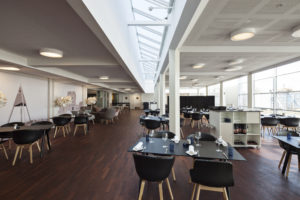
The cycle of natural light is fundamental to our wellbeing and ability to maintain a healthy circadian rhythm. Daylight improves our productivity and ability to focus, and furthermore it also reduces energy consumption for artificial lighting. The conference rooms at Green Solution House are designed to accommodate meetings in broad daylight, utilizing diffused light from the north. Inside the hotel rooms, daylight conditions have been optimised with retrofitted glass balconies. VELUX Sun Tunnels and Parans light cables redirect daylight to every nook and corner, where natural light is limited. In all common areas and hallways, skylights are utilised to create a comfortable indoor climate with generous daylight levels. Altogether, a strong focus on daylight driven design has helped to create well-lit spaces, resulting in better user experience and less energy consumption.
Clean air is essential to optimising the quality of indoor environments. At Green Solution House we have created a variety of solutions that contribute to keeping our air fresh and pollutant free. The carpets on the floor absorb dust particles, the plasterboard on the walls take care of formaldehyde, and the roof membrane captures and neutralises pollution particles from traffic. The Green Wall in the Third Climate Zone naturally purifies the air with plants and balances humidity levels.
At Green Solution House we have been successful in balancing the thermal environment for optimal indoor comfort. We achieve comfort by balancing natural ventilation, mechanical ventilation and our heating strategy in response to the seasons. This strategy has resulted in the highest score possible in the Active House analysis of comfort in the building. Our diffuse ventilation strategy supplies fresh air through permeable acoustic panels in the conference center and restaurant ceiling and has two major advantages in terms of indoor climate. First, the even distribution lets us use cooler air without causing discomfort and drafts, and thus reduces supply air requirements and duct sizing. Second, by supplying cool air through the acoustic panels they act as a chilled ceiling, further supporting comfort by radiative cooling. In floor heating and cooling is supported by our on-site thermal energy storage system. Thermal glazing in the conference center maximises indoor comfort relative to solar exposure.
Energy
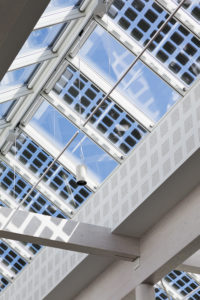
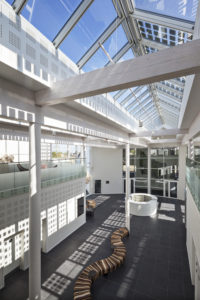
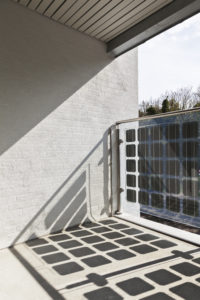
Insulated Facade Plastered directly on mineral wool this solution is a durable mineral façade. The solution is installed on a base of masonry, concrete and wood and ensures a better indoor climate, preventing thermal bridging and cold outer walls. The façade solution is insulated with ISOVER glass wool that is produced from recycled glass.
At Green Solution House we know where our energy comes from and where it goes. The interactive energy visualisation in our lobby both tracks our energy footprint and correlates it to carbon and resource impact. On-site we produce our own energy for consumption, and make up the difference between demand and production by either consuming energy from, or selling it back to, the Bornholm grid. Aligned with our goal of continuous improvement we want an ongoing and thorough understanding of the resource mix used to produce our power – this means understanding the fluctuations between highly renewable energy and highly resource dependent energy. With this understanding, we correlate our operational practices to best mitigate environmental impacts. Together with the day-to-day operations, our guests influence our consumption profile; as such, our energy visualisation is an interactive learning tool – correlating the characteristics and impact of use to behaviour and routine.
Our solar balconies generate electricity and let in more daylight! During the retrofit of the main building, all balconies were changed from concrete to glass and those on the south façade were equipped with photovoltaic cells. Now the solar balconies produce an extra 5000 kWh of energy per year for the building. In addition, the glass balcony railings let significantly more daylight into the hotel rooms than before.
At Green Solution House we produce energy from food leftovers. All food scraps and organic materials from the main building are fed into our own stationary pyrolysis plant, which likes all carbon based waste. The material is first dried and ground, then all oxygen is removed. The pyrolysis process heats the waste, breaking it down to produce natural gas and char. A cyclone separates off the gas leaving biochar, which sequesters carbon in a stable state. Biochar is valuable as an additive for the gardens as it improves soil health and water retention. The gas is combusted in a combined heat and power engine, generating heat and electricity to be used in the building. The system is self-supporting, and only requires a small amount of energy to start up. Excess heat is stored onsite as hot water in a swimming pool, repurposed as a thermal energy storage system.
Environment
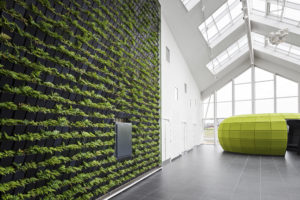
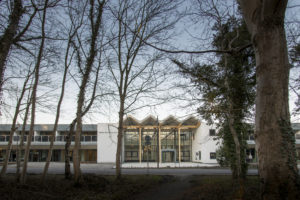
When we choose materials and products for Green Solution House they have to meet or exceed high standards. We developed our own criteria to select materials, prioritising certifications and environmental labels, recyclability, social responsibility, use of resources, safety of compounds, and energy in production, to name a few. We send out questionnaires to producers and suppliers, in order to gain knowledge of the ingredients, installation options and production methods. If a material or product has harmful substances or a negative production footprint, we source alternatives. As a result we have many solutions that are designed for disassembly, Cradle to Cradle Certified™, and have a positive impact beyond their mere function.
To be transparent is to first be aware, responsive and accountable; secondly, it is to be open and communicative. Making ethical material choices is at the core of the Green Solution House vision and we want the whole picture when it comes to the products we select for construction. At the Green Solution House we worked with a material filter, our own selection criteria, to secure quality and sustainability of the materials used in the buildings and landscape. This process enables selection based on a value framework that accounts for full resource and energy lifecycles as well as the day-to-day contributions to the health of our environments. In support of transparency and DGNB certification, products are reviewed to the detail of chemical composition and documented in our list of materials.
The new building is constructed with wood. Usually the environmental footprint of a building’s construction is substantial – at Green Solution House we lowered ours by using wood, as opposed to steel or concrete. Wood is a natural and renewable material – that is, if it comes from responsible and sustainable forestry operations, which ours does. By using a laminated wood construction to form the fan shape of the building, the design has the benefit of being visible, giving the spaces a comfortable and warm aesthetic.


